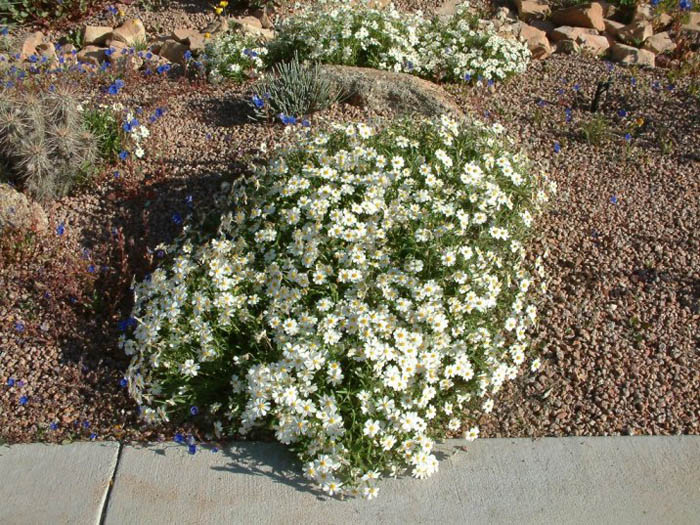Melampodium leucanthum
Blackfoot Daisy

Description
Small mounding perennial grows quickly to 1' x 2'. White daisylike flowers with yellow centers cover the plant nearly year-round The leaves are narrow and gray-green. Accepts full sun or partial shade but blooms better in the sun. Bright and colorful groundcover. Plant in well-drained soil. Native to the southwest U.S. and Mexico.
Maintenance Tips
Melampodium leucanthum or the Blackfoot Daisy, is a small herbaceous perennial that reaches 12 – 18" tall and wide. It is very drought and heat-tolerant and requires very little maintenance to look and perform its best. Once the plant is established, it requires very little water, but it does tend to have a much longer blooming cycle if it is offered supplemental water during the spring and summer. It is very attractive to birds, butterflies, and bees and is usually pest-free. As an herbaceous perennial, it can be attractive to aphids and other soft-bodied insects that can damage the foliage. Instead of using pesticides to control these pests, it would be better to use a hard jet of water or even bring in ladybugs to treat the infestation. That will ensure the beneficial insects and birds can continue to enjoy the flowers.
Plant Type
Perennial
Height Range
1-3'
Flower Color
White
Flower Season
Spring, Summer, Fall
Leaf Color
Grey Green
Bark Color
n/a
Fruit Color
n/a
Fruit Season
n/a
Sun
Full, Half
Water
Low
Growth Rate
Fast
Soil Type
Sandy, Clay, Rocky
Soil Condition
Well-drained
Soil pH
Neutral, Basic
Adverse Factors
Attracts Bees
Design Styles
Mediterranean, Spanish, Wild Garden
Accenting Features
Showy Flowers
Seasonal Interest
Winter, Spring, Summer, Fall
Location Uses
Perennial Border, Parking Strip, Patio, Raised Planter, Swimming Pool, Walkways, With Rocks
Special Uses
Container, Filler, Mass Planting, Small Spaces, Hanging Baskets
Attracts Wildlife
Birds, Butterflies
Water Saving Tip:
Be sure to fix all leaks promptly no matter how small they may seem.